
Dropbox Review 2025: Is the Cloud Storage Pioneer Still Up to Date?
Dropbox made cloud storage popular. Today, many services offer basically the same thing. Dropbox is now just one of many providers. Can it still compete in a market full of alternatives?
We thoroughly tested Dropbox to find out if this cloud storage pioneer still ranks among the best - or if other services have taken the lead.
Dropbox* is a cloud storage service that lets you store files online, sync them across devices, and share them with others.
For many years, the name Dropbox was almost synonymous with cloud storage, like Kleenex is for tissues. The service has been around since 2008, when cloud storage was still new to most people. Now, storing files in the cloud has become standard - and there are many Dropbox alternatives.
With over 18 million paying users, Dropbox remains one of the most popular cloud storage solutions. The service hasn't stood still - it has steadily added new features over the years. It even competes with Google and Microsoft's office suites by offering its own document editor.
But is Dropbox still a good choice, or has the competition passed it by? You'll find out in our review.
For more information about how Dropbox works and a setup guide, check here:
Dropbox Review
User-friendly interface
Dropbox offers a clean, organized interface that stays easy to use despite having many features.Powerful collaboration platform
With Dropbox Paper, you get a powerful collaboration platform built in. You can not only store files in the cloud but also edit them directly with real-time collaboration.Cross-platform access
Whether you're using the web, desktop, or smartphone - Dropbox provides reliable access to your files on all devices.End-to-end encryption
Business plans include E2E encryption that you can apply to team folders of your choice. This keeps your data safe even from Dropbox itself.
Expensive and inflexible
Without entry-level plans, Dropbox is relatively expensive if you need less than 2 TB of storage. The free plan is also limited in usefulness due to its 2 GB cap.High CPU usage during testing
In our performance test, file syncing used more system resources compared to many competitors.E2E encryption for teams only
End-to-end encryption is only available with business plans. Individual users have to settle for server-side encryption.Many negative customer reviews
Review sites show many complaints - particularly about poor customer support and data loss.
Interface and Ease of Use
| Platforms | No Windows 7/8 support | 3.5/4 |
| Web Interface | User-friendly web app that remains clear despite many features. | 3/4 |
| Desktop App | Not a real app, but rather a sync tool with some advanced settings. | 3/4 |
| Mobile App | Contains all important features of the web interface and automatically syncs photos. | 2.5/3 |
Dropbox's apps and interfaces have gone through many changes over the years. The current version looks great: Dropbox stands out with its sleek, modern interface that neatly organizes the platform's impressive range of features.
Like all cloud storage services, you can access your files and tools in three main ways: through the website, desktop app, or mobile app. Let's look at each one.
Optimized for Chrome, Firefox, Edge, Safari
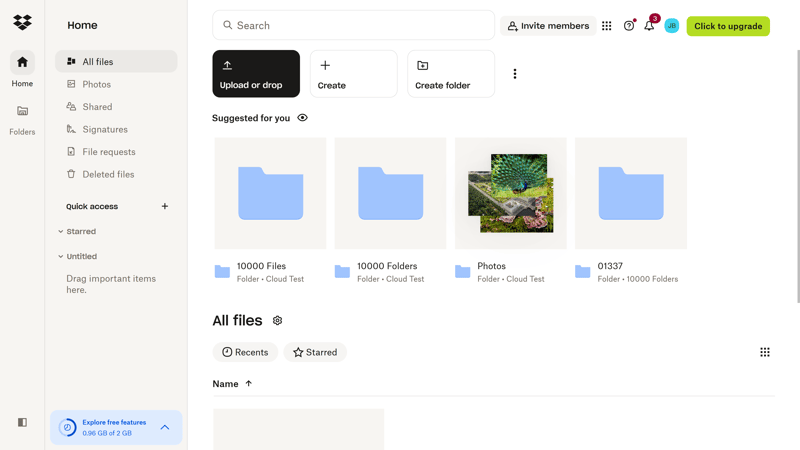
The Dropbox web interface.
The web interface lets you access your files directly in your browser and manage your cloud folders. All you need are your login details and an internet connection.
The interface has a modern design that stays organized despite its many features and options. It offers simple navigation that even less experienced users should find easy to use. It's divided into four main areas:
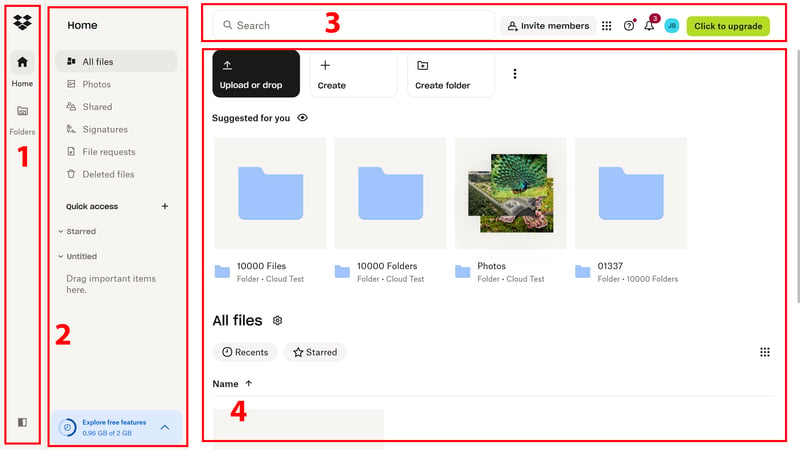
The interface is clear and logically organized.
- 1.
Left sidebar: Dropbox has two sidebars. The (relatively new) navigation bar on the far left makes it easy to access your cloud files: In the "Folders" menu, you can see all your cloud storage folders listed in a clear directory.
- 2.
Navigation bar: The second navigation bar lets you switch between the main areas and features of your cloud storage. Here you'll find special views for your photos, shared files, deleted files, signatures, and file requests. There's also a "Quick access" section where you can save favorites and frequently needed content.
- 3.
Top menu bar: Use the search bar on the left to look for specific folders and files. Unlike Google Drive, it only searches titles, not document contents. You can also invite members, switch to other Dropbox apps, and access your account settings here.
- 4.
Main area: The main area takes up most of the screen. It changes based on what you're doing: In the "All files" section, you'll find action buttons at the top for uploading and creating folders and content, followed by your cloud files.
While Dropbox's web app has a lot going on, its clear structure and easy navigation keep it from feeling overwhelming. The main features are easy to reach, and all areas - from navigation to file view - are laid out logically.
One of Dropbox's best features is that you can edit your documents directly in the cloud. With their own platform Dropbox Paper, Dropbox offers a central workspace for teams where you can edit documents together, add media like videos and code, and handle basic project management tasks (more on this later).
Dropbox works great with Microsoft Office and Google Workspace documents too. It even includes an e-signature feature.
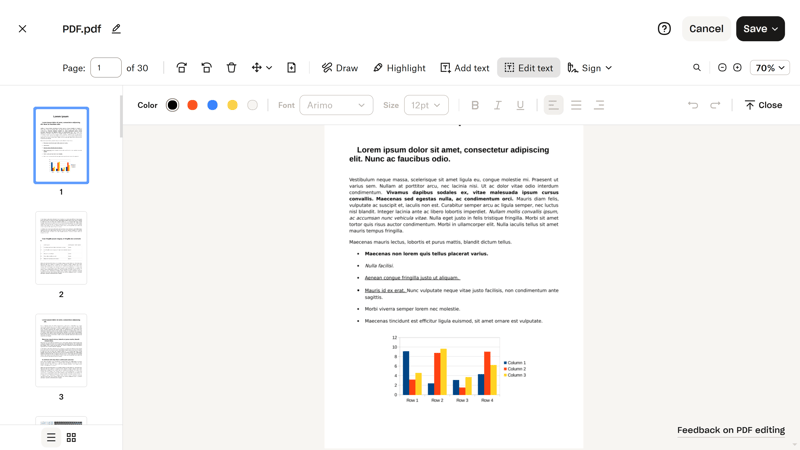
You can open and edit documents directly in the cloud.
You can also open photos and videos right in the cloud storage without downloading them first.
The Dropbox web app is really well-rounded: You can manage your cloud files and edit documents right in the cloud. It runs smoothly too - in our test, the web interface stayed quick and didn't slow down even when opening large folders.
Windows, Mac, Linux
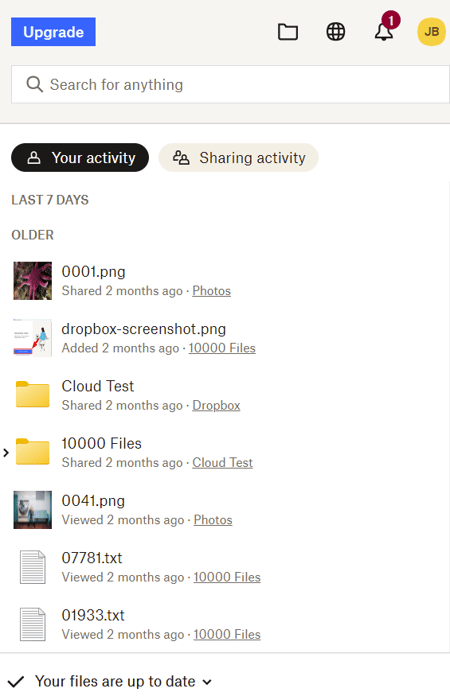
The Dropbox desktop app.
If you want to access your cloud files directly from your computer (and use them offline), you'll need to install the Dropbox desktop app. It's pretty basic and mainly works as a sync tool for your files. It sits in the taskbar and offers just a few features at first glance.
The home screen shows an overview of current sync activities. In the top bar, you'll find a search feature and links to your Dropbox folder and web interface.
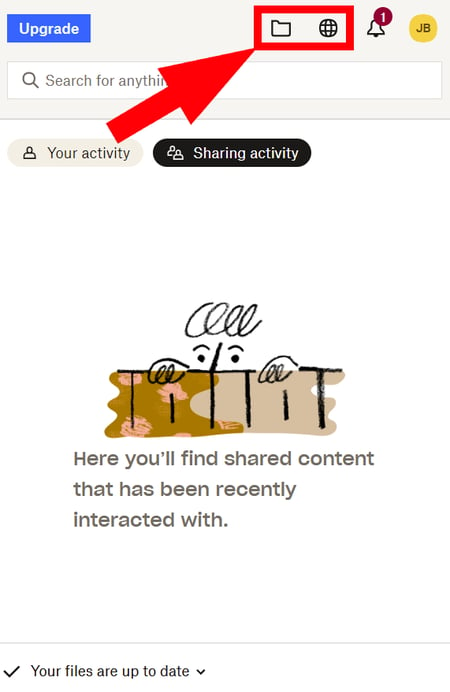
The desktop app takes you to your cloud folder and web interface.
You'll mainly manage your files directly in the file manager. Your Dropbox folder works just like any other folder on your computer - you can move, copy, and delete files as usual.
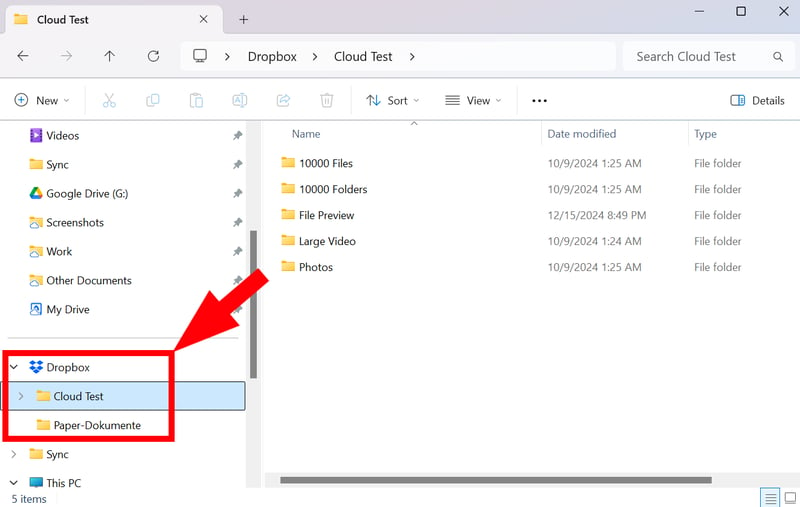
You can manage your cloud files directly in the file manager.
Dropbox stands out with its unobtrusive desktop experience, making cross-device syncing smooth and simple.
Android, iOS
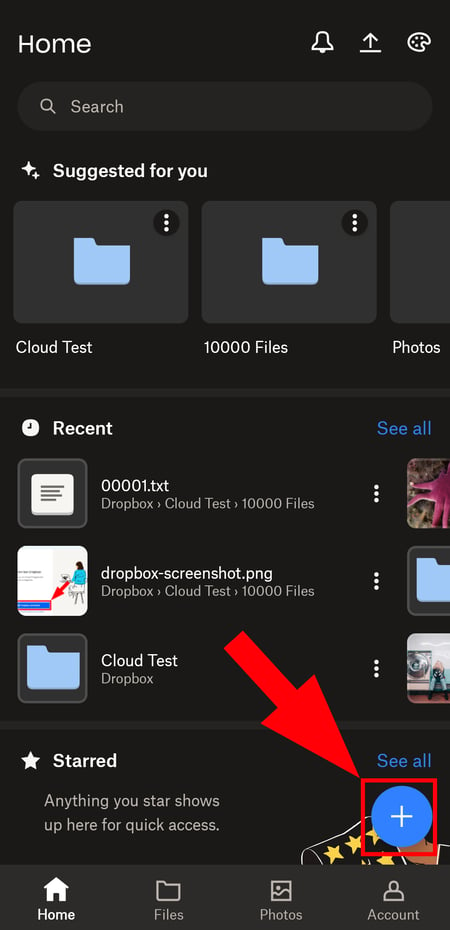
Tap the plus icon to create new files or upload photos and scans to the cloud.
Dropbox also offers a mobile app that gives you access to your cloud storage files on the go. It includes all the key features of the web app, with some adjustments and add-ons for mobile use. This includes a scan feature that lets you scan documents and save them directly to your cloud storage.
Here's a list of all platforms that Dropbox supports:
| Dropbox | Tresorit | pCloud | MEGA | Icedrive | STRATO | IONOS | Sync.com | Microsoft OneDrive | Google Drive | Proton | |
|---|---|---|---|---|---|---|---|---|---|---|---|
| Desktop | |||||||||||
| Windows 7/8 | ✗ | ✓ | ✓ | ✓ | ✓ | ✓ | ✓ | ✗ | ✗ | ✗ | ✗ |
| Windows 10/11 | ✓ | ✓ | ✓ | ✓ | ✓ | ✓ | ✓ | ✓ | ✓ | ✓ | ✓ |
| macOS (Intel) | ✓ | ✓ | ✓ | ✓ | ✓ | ✓ | ✓ | ✓ | ✓ | ✓ | ✗ |
| macOS (Apple Silicon) | ✓ | ✓ | ✓ | ✓ | ✓ | ✓ | ✓ | ✓ | ✓ | ✓ | ✓ |
| Linux | ✓ | ✓ | ✓ | ✓ | ✓ | ✗ | ✗ | ✗ | ✗ | ✗ | ✗ |
| Mobile | |||||||||||
| iOS | ✓ | ✓ | ✓ | ✓ | ✓ | ✓ | ✓ | ✓ | ✓ | ✓ | ✓ |
| Android | ✓ | ✓ | ✓ | ✓ | ✓ | ✓ | ✓ | ✓ | ✓ | ✓ | ✓ |
| Total | 6 | 7 | 7 | 7 | 7 | 6 | 6 | 5 | 5 | 5 | 4 |
Dropbox has grown a lot over the years, but it's still easy to use. The main features - storing and syncing files in the cloud - work smoothly, and the extra features, especially the powerful collaboration tools, fit perfectly into the existing workflow.
Storing & Syncing Files
| Synchronization |
| 5/5 |
| Performance |
| 6/10 |
All files you save in your Dropbox cloud storage automatically sync across all your devices. When you edit a file in the web interface, the changes update on your desktop and smartphone app too, and vice versa.
Desktop Sync: The Dropbox Master Folder
Dropbox uses a "master folder" system for syncing. Instead of syncing files directly from their current location to the cloud, it creates a special local folder where you copy all files and folders you want to sync.
During installation, you'll set up your "Dropbox folder" on your computer:
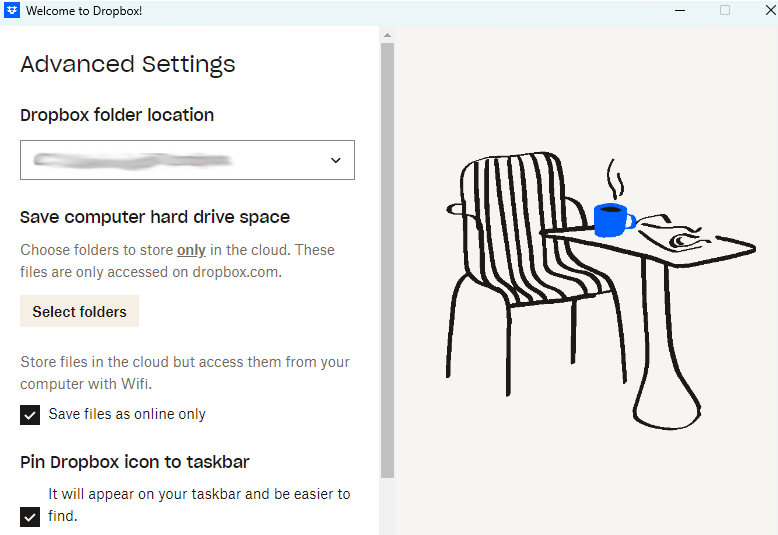
Choose your Dropbox folder location during installation.
All files and folders in the Dropbox folder sync with the cloud. In the settings, you can choose between two sync options:
Online only: By default, files in your Dropbox folder are stored online only. This means they don't take up hard drive space - but you need an internet connection to open them. You can still see them in your Dropbox folder when offline.
Available offline: This setting lets you access your cloud files offline. However, they will take up space on your hard drive. The files sync and update with the cloud when you're back online.

Dropbox lets you access your cloud files both online and offline.
In the sync settings, you'll find a feature called "Selective Sync." This lets you choose which cloud folders you want to show and sync locally.
Only folders you select here will appear in your desktop Dropbox folder. You can access unselected folders only through the web interface. This feature comes in handy when you know you'll only work with specific files on your computer and don't want other cloud folders to distract you (or take up storage space).
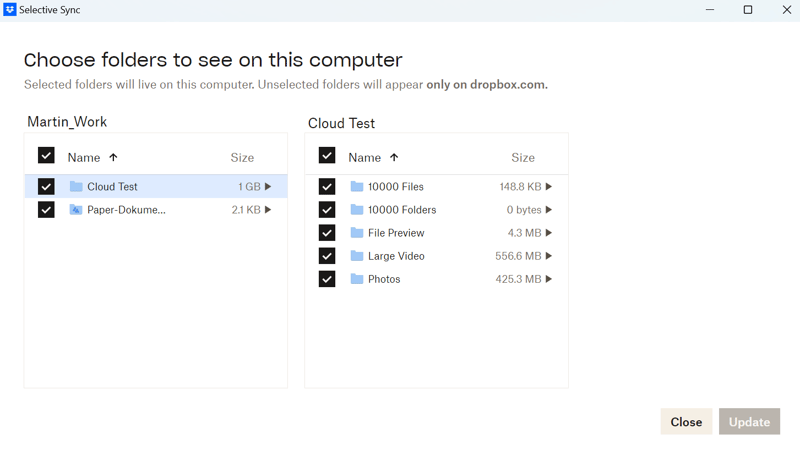
Selective sync lets you pick which folders to store on your computer.
Backups: Store Your Files and Photos in the Cloud
Dropbox now includes a backup feature that lets you save your files in the cloud. Unlike regular sync, backup focuses on protecting your data from loss: copies of your files are automatically saved in the cloud, where you can restore them when needed.

Dropbox has added a backup feature.
By default, backups run every 15 minutes. You can change this to daily or weekly backups, or set up your own schedule. Depending on your plan, you can also back up external hard drives.
Dropbox can't compete with dedicated cloud backup solutions. Files (including previous versions) are kept for 30 days by default, with a maximum of "only" 180 days. Many key features are also limited to individual users: Business plans, for example, only support backups for selected folders - you can't choose just any folder to back up.
A full-featured cloud backup program offers many more options:
Advanced Settings: Bandwidth, Proxy, LAN
Dropbox offers several advanced settings that let you customize how syncing works based on your needs.
You can set limits for upload and download speeds. This comes in handy if you have a slow internet connection and don't want Dropbox using all your bandwidth, or if you want to prioritize other online activities like video calls or streaming.
Dropbox also supports LAN sync, which speeds up file syncing within a local network. If your network uses a proxy server (common in offices or universities), you can manually adjust the proxy settings in Dropbox.
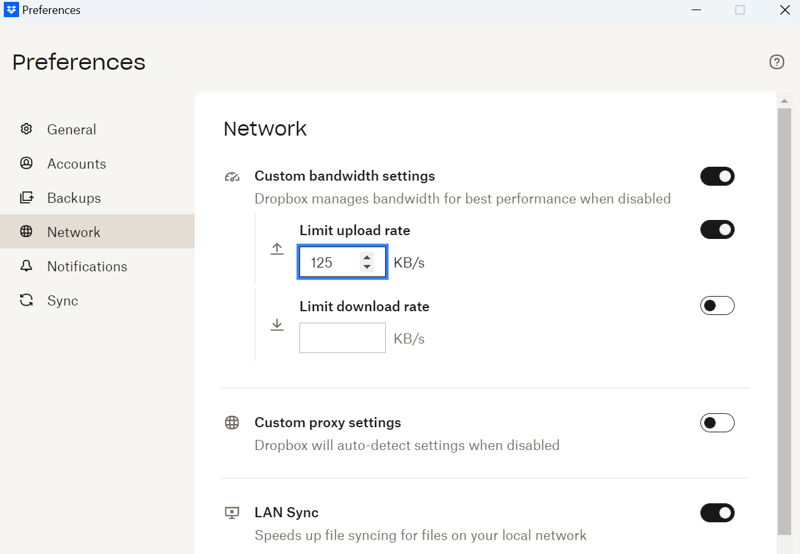
Advanced features in the Dropbox desktop app
Mobile App With Offline Mode and Photo Sync
The mobile app doesn't have sync modes - by default, you access files directly from the cloud. However, you can make selected folders and files available offline, but this feature is only available with Dropbox Plus.

You can make files and entire folders available offline.
Dropbox is also great for storing your photos. You can set up automatic uploads for your photos and videos to your Dropbox storage, and manually upload new photos.
Here's an overview of Dropbox's key sync features compared to other providers:
| Dropbox | pCloud | MEGA | Tresorit | Microsoft OneDrive | Icedrive | Sync.com | Google Drive | STRATO | Proton | IONOS | |
|---|---|---|---|---|---|---|---|---|---|---|---|
| Selective Sync | ✓ | ✓ | ✓ | ✓ | ✗ | ✓ | ✓ | ✗ | ✓ | ✗ | ✓ |
| Online Mode | ✓ | ✓ | ✓ | ✓ | ✓ | ✓ | ✓ | ✓ | ✗ | ✓ | ✗ |
| Back up System Folders | ✓ | ✗ | ✓ | ✗ | ✓ | ✓ | ✗ | ✓ | ✗ | ✗ | ✗ |
| LAN Sync | ✓ | ✓ | ✗ | ✗ | ✗ | ✗ | ✗ | ✗ | ✗ | ✗ | ✗ |
| Limit Speed | ✓ | ✓ | ✓ | ✓ | ✓ | ✗ | ✗ | ✗ | ✗ | ✗ | ✗ |
| Total | 5 | 4 | 4 | 3 | 3 | 3 | 2 | 2 | 1 | 1 | 1 |
How Well Does Dropbox Perform?
Speed and reliability are key factors for cloud storage. To measure Dropbox's performance objectively, we looked at three metrics:
Upload speeds
How fast can files be uploaded to the cloud?Download speeds
How fast can files be downloaded from the cloud?CPU performance
How much does syncing impact system performance?
To ensure a fair comparison between different providers, we measured all metrics under identical conditions. We created a test folder with exactly the same content for each cloud service and synced it using a PC with a 400 Mbps connection (upload and download).
The test folder included:
10,000 files
10,000 folders
100 photos (about 500 MB)
1 large video (about 500 MB)
Here are the results:
| Upload | Download | CPU Usage | |
|---|---|---|---|
| MEGA | 00:09:45 | 00:10:00 | 47 % |
| pCloud | 00:10:00 | 00:04:30 | 31 % |
| Microsoft OneDrive | 00:25:00 | 00:11:30 | 34 % |
| Google Drive | 00:27:30 | 00:18:45 | 43 % |
| Dropbox | 00:30:45 | 00:10:00 | 73 % |
| Tresorit | 00:37:00 | 00:13:00 | 31 % |
| Sync.com | 00:38:30 | 00:03:30 | 33 % |
| Icedrive | 00:41:15 | 00:11:45 | 81 % |
| IONOS | 01:17:30 | 00:39:00 | 22 % |
| STRATO | 01:27:30 | 00:41:00 | 23 % |
| Proton | 01:33:45 | 00:35:30 | 27 % |
Dropbox's performance was mixed. While download speeds were solid, upload speeds were just average. The most disappointing aspect was CPU usage: Dropbox is one of the most resource-hungry providers in our review - only Icedrive used more system resources.
Dropbox makes syncing across devices simple: You can manage and organize your cloud files through Dropbox's "Master Folder," which you can also access offline if needed. It works well as a basic cloud backup solution too.
However, sync performance could be better: While speeds were okay, CPU usage was much higher than other cloud storage services in our review. We expected more from an industry leader like Dropbox.
File Sharing and Collaboration
| Share files via link |
| 4/5 |
| Share folders with users | Fast and easy sharing. User management and roles could be more extensive in solo plans. | 3/5 |
| Request files | Yes | 2/2 |
| Team features |
| 7/8 |
Most cloud storage services now call themselves "collaboration platforms." But only a few providers truly live up to this name. Dropbox is one of them: You can share files and edit them directly in the cloud, working on them in real-time with others - just like with Microsoft OneDrive or Google Drive.
File Sharing: Share Links and Folders
Let's start with file sharing. You'll find a prominent "Share" button in all interfaces that lets you share your folders and documents with others:
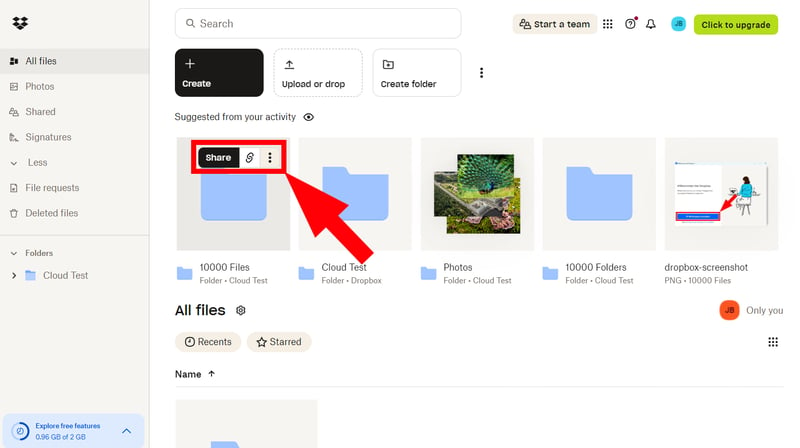
You can share folders and files with others.
You have two main options:
- 1.
Share link: You can create a link to any resource in your Dropbox account to share with others. The recipient doesn't need a Dropbox account to access the file or folder.
- 2.
Share folder: You can give specific users access to a folder in your Dropbox account. The benefit: You have more control over permissions, and invited users can view, edit, or add their own files depending on the access rights you give them. This option requires a Dropbox account.
Let's take a closer look at both options:
Share Files and Folders Using Links
Link sharing is a quick and easy way to share files or folders. This works even for people who don't have a Dropbox account - though they can only preview documents, not edit or share them.
When you share folders and files with other Dropbox users, you can give them editing access (more on this below).
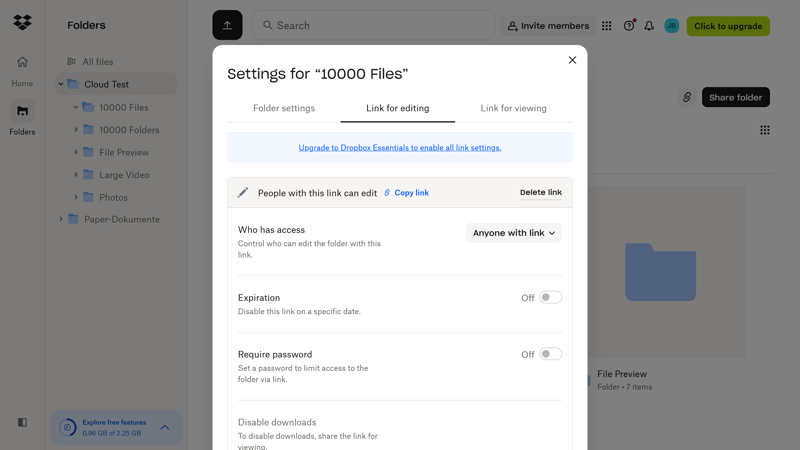
Link sharing is quick and easy.
You can set the link to allow anyone to view the files or limit access to invited people only. There are also some advanced link settings, like password protection and expiration dates, but these are only available with the Essentials plan. Link tracking features, like those offered by Sync.com, are not supported.
Share Folders With Other Dropbox Users
If you often work on projects or documents with other Dropbox users, it's easier to share entire folders instead of individual files. With Dropbox, you can invite specific users and assign them permissions.
There are three roles:
- 1.
Owners have full control over the folder and can manage access rights, invite or remove other users. Only a member of your team can be an owner of a folder in your cloud storage.
- 2.
Editors can edit, add, or delete files. Changes sync automatically for everyone.
- 3.
Viewers can only read, view, and download files, but can't make any changes.
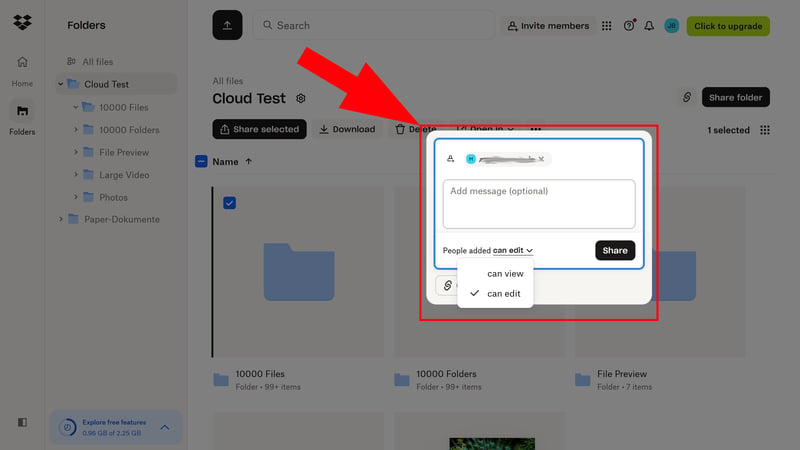
You can set user roles.
Dropbox team accounts offer advanced options and additional user roles. There's a distinction between admins and team members, with eight different admin roles that have varying permissions. This allows for detailed access and management rights - but only in team plans.
Here are Dropbox's main sharing features compared:
| Dropbox | Tresorit | Sync.com | pCloud | STRATO | Microsoft OneDrive | MEGA | IONOS | Icedrive | Proton | Google Drive | |
|---|---|---|---|---|---|---|---|---|---|---|---|
| Share Files via Link | ✓ | ✓ | ✓ | ✓ | ✓ | ✓ | ✓ | ✓ | ✓ | ✓ | ✓ |
| Password Protected Links | ✓ | ✓ | ✓ | ✓ | ✓ | ✓ | ✓ | ✓ | ✓ | ✓ | ✗ |
| Expiration Date for Links | ✓ | ✓ | ✓ | ✓ | ✓ | ✓ | ✓ | ✓ | ✓ | ✓ | ✗ |
| Statistics for Links | ✗ | ✓ | ✓ | ✓ | ✗ | ✗ | ✗ | ✗ | ✗ | ✗ | ✗ |
| Share Folders With Users | ✓ | ✓ | ✓ | ✓ | ✓ | ✓ | ✓ | ✓ | ✓ | ✓ | ✓ |
| Request Files | ✓ | ✓ | ✓ | ✓ | ✓ | ✓ | ✓ | ✓ | ✓ | ✗ | ✓ |
| Total | 5 | 6 | 6 | 6 | 5 | 5 | 5 | 5 | 5 | 4 | 3 |
Real-Time Collaboration With Dropbox Paper
What makes Dropbox special is that you can not only sync and share your cloud documents but also edit them directly in the cloud - both alone and with others. Dropbox now focuses more on being like collaboration tools such as Microsoft 365 and Google Workspace rather than "pure" cloud storage services like MEGA or Tresorit.
For this purpose, Dropbox has developed its own platform called Dropbox Paper. It combines a powerful document editor with collaboration and project management features.
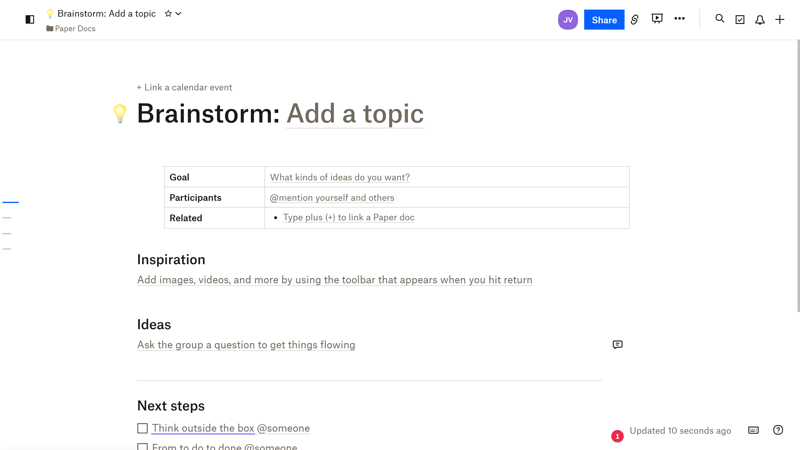
Dropbox Paper is Dropbox's own collaboration platform.
Dropbox wants you to stay within their cloud storage and handle all your project planning and execution directly in Dropbox Paper.
The platform comes with an impressive set of features. Here are some of the most important ones:
Document Editor
Dropbox Paper comes with a solid editor that covers all essential formatting features. You can add images, videos, tables, and even content from Airtable, Figma, Framer and other third-party tools. Of course, Dropbox also supports opening and exporting Microsoft Office and Google documents. You can even edit PDF files.Real-time Collaboration
Multiple team members can work on a document at the same time. You can see who's currently viewing the document and track changes instantly.Project Management Tools
While it can't compete with dedicated project management platforms, Dropbox offers good basic task management. You can add to-do lists and assign tasks with due dates to specific team members.

Dropbox Paper offers basic task management features.
Comments and Mentions
You can leave comments in documents and tag team members using @mentions to communicate within specific documents.
All-in-one platforms often end up feeling bloated or half-baked. However, Dropbox Paper is a useful addition to Dropbox's cloud storage features. While it can't match Google Workspace's ease of use and integration options, it offers smaller teams a simple way to create and organize content together and share feedback.
For large projects and big teams, the features are too limited - and with just a few task management tools, it's not a replacement for proper project management software. Also, the editor could be faster: opening and switching between documents is much smoother in Google's tools.
Here's how Dropbox's collaboration features compare to other providers:
| Dropbox | Microsoft OneDrive | Google Drive | Sync.com | Proton | Tresorit | STRATO | pCloud | MEGA | IONOS | Icedrive | |
|---|---|---|---|---|---|---|---|---|---|---|---|
| Team Management | ✓ | ✓ | ✓ | ✓ | ✗ | ✓ | ✓ | ✓ | ✓ | ✓ | ✗ |
| User Roles / Access Rights | ✓ | ✓ | ✓ | ✓ | ✓ | ✓ | ✓ | ✓ | ✓ | ✓ | ✗ |
| Comments | ✓ | ✓ | ✓ | ✓ | ✓ | ✗ | ✗ | ✗ | ✗ | ✗ | ✓ |
| Edit Documents | ✓ | ✓ | ✓ | ✗ | ✓ | ✗ | ✗ | ✗ | ✗ | ✗ | ✗ |
| Total | 4 | 4 | 4 | 3 | 3 | 2 | 2 | 2 | 2 | 2 | 1 |
Dropbox combines cloud storage and collaboration: you can share your files and documents with others and work on them together with just a few clicks.
The combination mostly works well: Dropbox Paper fits smoothly into the cloud storage interface and stands out with its powerful document editor, real-time collaboration, and built-in task management tools. But don't expect it to beat Google Workspace - collaboration still feels more like an extra feature than a core part of Dropbox.
Security & Privacy
| End-to-end encryption | E2E encryption is only available in business plans, not for individual users. | 5/10 |
| File versioning | Yes, in all plans | 3/3 |
| Two-factor authentication | Yes | 2/2 |
| GDPR-compliant | Yes, but only in business plans can servers in the EU be selected | 1/2 |
| ISO Certification | ISO 27001 and ISO 27018 | 2/2 |
| Transparency reports | Yes | 2/2 |
| Jurisdiction | USA | 0/2 |
| Security assessment | Dropbox fundamentally meets high security standards and undergoes regular external audits. However, there have been occasional security incidents in the past. | 3/5 |
From a privacy perspective, cloud storage can be divided into two categories: those with end-to-end encryption (E2E) and those without. Dropbox was in the second category for a long time but finally introduced an E2E option in 2024. However, this option is only available in team plans.
Not all encryption offers the same protection. It's important to understand where and how your files are encrypted. Cloud storage mainly uses two types of encryption:
End-to-end encryption (E2E): Files are only encrypted and decrypted on users' devices. The keys never reach the provider's servers, which is why it's called "zero knowledge." This means neither the cloud service nor third parties can access the content - even in case of a hack, internal data leak, or government requests.
Server-side encryption: Files are stored encrypted on the provider's servers and are usually well-protected against outside attacks. However, the provider keeps the decryption keys. This creates several risks: If the provider gets hacked or experiences an internal data leak, unauthorized people could get the keys and access your content. Also, the provider could technically decrypt and reveal your files, for example, when requested by authorities.
Dropbox combines both approaches but only offers the E2E option to teams. Business plan users can enable E2E encryption for selected folders with one click. Then, encryption and decryption only happen locally on approved devices.
For all other files (and users outside team plans), Dropbox uses 256-bit AES encryption. This protects files during transfer (via TLS/SSL) and when stored ("at rest") on servers. However, Dropbox keeps the decryption keys and can technically access the data.
While Dropbox - like other cloud storage services - generally maintains high security standards, it has experienced some hacks and data leaks. The most notable was the 2012 data breach, when hackers stole over 68 million Dropbox user passwords. Though the passwords were hashed (encrypted), they weren't protected well enough. This incident remains the biggest cloud storage hack in history.
Since Dropbox is one of the most popular cloud storage services, it remains a frequent target for phishing and other attacks. Don't rely solely on encryption - use a strong password and enable Dropbox's two-factor authentication to add extra security to your account.
Compliance and Transparency
Dropbox meets common international security standards and regularly has its systems checked by independent auditors like EY. This includes certifications like ISO 27001 for information security and ISO 27018 for cloud privacy.
The control mechanisms are also audited yearly according to SOC 1 and SOC 2 Type II. Reports like the SOC 3 audit report by EY are publicly available and show an overview of security measures.

Dropbox regularly publishes transparency reports.
Since 2012, Dropbox has published a transparency report twice a year. This report shows how many government requests they receive for data disclosure or content removal, what types of requests they are, and how Dropbox responds to them.
GDPR and Server Locations
Dropbox claims to be GDPR compliant, but companies are responsible for ensuring their own legal compliance.
Business plans give you more control over your data management and sovereignty. You can choose end-to-end encryption and store your files in data centers. By default, Dropbox uses servers in the USA.
Here's an overview of Dropbox's main privacy features:
| Dropbox | Tresorit | Proton | Microsoft OneDrive | MEGA | Google Drive | STRATO | pCloud | IONOS | Icedrive | Sync.com | |
|---|---|---|---|---|---|---|---|---|---|---|---|
| Security | |||||||||||
| End-To-End Encryption Possible | ✓ | ✓ | ✓ | ✗ | ✓ | ✗ | ✓ | ✓ | ✓ | ✓ | ✗ |
| E2E Encryption by Default | ✗ | ✓ | ✓ | ✗ | ✓ | ✗ | ✗ | ✗ | ✗ | ✗ | ✗ |
| Two Factor Authentication | ✓ | ✓ | ✓ | ✓ | ✓ | ✓ | ✓ | ✓ | ✓ | ✓ | ✓ |
| File Versioning | ✓ | ✓ | ✓ | ✓ | ✓ | ✓ | ✓ | ✓ | ✓ | ✓ | ✓ |
| Data Protection | |||||||||||
| GDPR Compliant | ✓ | ✓ | ✓ | ✓ | ✓ | ✓ | ✓ | ✓ | ✓ | ✓ | ✓ |
| ISO 27001 Certification | ✓ | ✓ | ✓ | ✓ | ✗ | ✓ | ✓ | ✓ | ✓ | ✗ | ✗ |
| ISO 27018 Certification | ✓ | ✓ | ✗ | ✓ | ✗ | ✓ | ✗ | ✗ | ✗ | ✗ | ✗ |
| Transparency Reports | ✓ | ✓ | ✓ | ✓ | ✓ | ✓ | ✗ | ✗ | ✗ | ✗ | ✗ |
| Jurisdiction | USA | Switzerland | Switzerland | USA | New Zealand | USA | Germany | Switzerland | Germany | UK | Canada |
| Total | 7 | 8 | 7 | 6 | 6 | 6 | 5 | 5 | 5 | 4 | 3 |
Dropbox offers high-level security and encryption standards using the latest technology. Business plan users now get optional end-to-end encryption. However, with personal plans, you'll have to accept that Dropbox technically has access to your data encryption keys.
Pricing
| Free (GB) | 2 GB | 2/8 |
| Price 100 GB | $9.99 | 0/2 |
| Price 500 GB | $9.99 | 1/2 |
| Price 2 TB | $9.99 | 2/2 |
| Price 5 TB | $72 | 0/2 |
| Price for 3 users | $16.99 | 1/2 |
| Price for 10 users | $150 | 0/2 |
Besides the free plan with 2 GB storage, Dropbox offers four standard plans for different users:
The Plus plan, designed for personal use, includes 2 TB storage, supports unlimited devices, and lets you transfer files up to 50 GB. You can recover deleted files for up to 30 days.
The Essentials plan, optimized for business use, offers 3 TB storage and increases the transfer limit to 100 GB. You can recover deleted files for up to 180 days. You also get extra features not available in the Plus plan, including advanced file sharing settings and PDF editing.
The Business plan is for small teams with at least three users. It starts with 9 TB storage for the whole team. This plan includes all Essential features, plus team features like team folders and admin roles.
The Business Plus plan is built for companies. Storage starts at 15 TB for the whole team, with a transfer limit of 250 GB. You can recover deleted files for up to one year, and you get single sign-on functionality.
Larger companies can use the Enterprise plan, but they need to contact Dropbox's sales team directly for pricing details.
Here's a current overview of Dropbox plans:
| Basic | Plus | Essentials | |
|---|---|---|---|
| Monthly Price | $0.00 | from $9.99 | from $16.58 |
| Contract Period (Months) | 0 | 1 - 12 | 1 - 12 |
| Limits | |||
| Storage Space | 2 GB | 2,000 GB | 3,000 GB |
| Number of Users | 1 | 1 | 1 |
| Number of Devices | 3 | unlimited | unlimited |
| Max. File Size | 2 GB | 2,000 GB | 2,000 GB |
| End-to-End Encryption | ✗ | ✗ | ✗ |
| File Versioning | 30 days | 30 days | 180 days |
Dropbox Price Comparison
Unfortunately, Dropbox is relatively expensive. Even their free plan is pretty stingy: almost all cloud storage providers in our review offer more space – MEGA even offers ten times as much.
Dropbox doesn't look great when comparing premium plans either. This is mainly because of their limited plan flexibility and the lack of an affordable starter plan: the minimum storage starts at 2 TB. While this amount is relatively cheap, you'll end up paying for storage you don't need if you require much less space. Teams can also find much better deals with other cloud storage solutions.
Here's a comparison of monthly costs from providers in our review for different storage sizes and number of users:
| Free | Price 100 GB | Price 500 GB | Price 2 TB | Price 3 TB | Price 3 Users | Price 10 Users | |
|---|---|---|---|---|---|---|---|
| MEGA | 20 GB | $8.33 | $8.33 | $8.33 | $16.67 | $15.00 | $50.00 |
| Google Drive | 15 GB | $1.67 | $8.33 | $8.33 | $1.67 | $57.50 | |
| pCloud | 10 GB | $4.17 | $4.17 | $8.33 | $49.58 | $23.97 | $55.93 |
| Icedrive | 10 GB | $3.99 | $5.99 | $10.99 | $49.96 | ||
| Sync.com | 5 GB | $4.76 | $7.21 | $7.21 | $18.02 | $16.22 | $54.05 |
| Proton | 5 GB | $3.99 | $9.99 | $23.99 | $23.99 | $83.89 | |
| Microsoft OneDrive | 5 GB | $1.67 | $5.59 | $15.75 | $8.25 | $55.93 | |
| Tresorit | 3 GB | $9.99 | $9.99 | $48.00 | $48.00 | $160.00 | |
| Dropbox | 2 GB | $9.99 | $9.99 | $9.99 | $54.00 | $16.99 | $120.00 |
| STRATO | 0 GB | $2.75 | $2.75 | $9.58 | $47.92 | $11.98 | $22.00 |
| IONOS | 0 GB | $1.50 | $3.85 | $15.00 | $3.00 | $15.00 |
If you're looking for 2 TB of cloud storage for personal use, Dropbox is actually quite affordable. However, if you need less or more space, you'll pay significantly more than with competitors because Dropbox just isn't flexible enough. They could also be more generous with their free storage.
Review Results
Many early innovators fade away over time. Luckily, Dropbox isn't one of them. This cloud storage pioneer keeps up with the times by regularly updating its interface without making it cluttered, and adding useful features to stay competitive.
While Dropbox's Paper collaboration platform can't compete with Google and Microsoft, it helps set Dropbox apart from basic cloud storage services that don't offer document editing.
Dropbox falls short with its pricing: The lack of flexible plans means many users pay more than they need to. They should also take notes from competitors about free storage space. In our review, we were also disappointed by high CPU usage during file syncing.
Overall, Dropbox remains a user-friendly cloud storage service in 2025, and with end-to-end encryption, it's now also appealing to businesses.

Dropbox User Experience
What do Dropbox users think about this cloud storage service? We looked at popular review sites and gathered common feedback. On Trustpilot, negative reviews are particularly common:
Easy file sharing
Users often praise how quick and simple it is to share large files. This feature is especially valued in work settings.User-friendly interface
Some users say the interface is easy to use and straightforward.
Security issues and data loss
Many users report security problems like unauthorized account access, lost files, or permanent file deletions.Poor customer service
Trustpilot users are very unhappy with support availability and quality. They say they get stuck with chatbots, receive unhelpful generic responses, or wait weeks for solutions.Pricing and subscription models
Users criticize high prices and confusing or pushy sales tactics. Some feel tricked by subscription traps or unwanted upgrades.Complex to use
Some users find it hard to navigate the service. This is especially true for casual and new users.
Alternatives to Dropbox
Not sure if Dropbox is right for you? Check out these alternatives:
Dropbox alternatives with E2E encryption in all plans
Want end-to-end encryption for personal use? Check out Proton Drive and MEGA.Cheaper than Dropbox
If 100 GB is enough for you, you'll find better deals with Google Drive and Microsoft OneDrive.Better for selective sync
Looking for cloud storage that lets you sync local folders directly without a master folder? Try MEGA or pCloud.
Here are the best Dropbox alternatives:

















